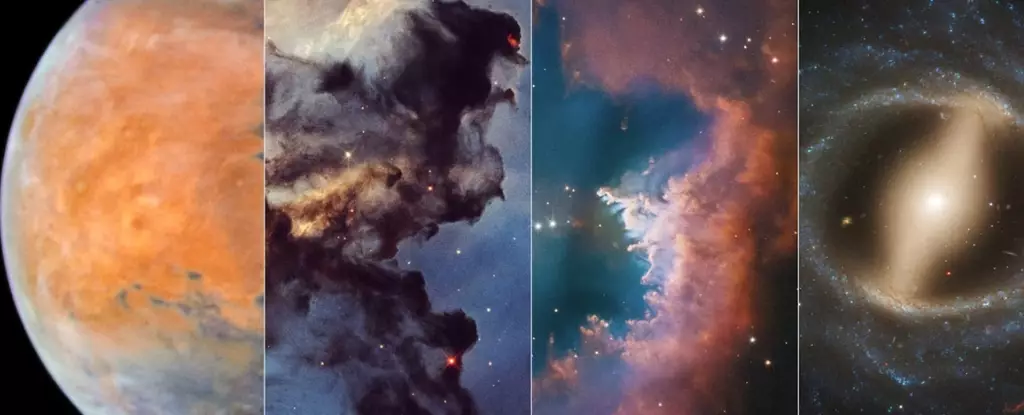This week marks a significant milestone as the Hubble Space Telescope celebrates its 35th anniversary. Rather than receiving gifts, the Hubble team is gifting us with mesmerizing images that remind us of the telescope’s monumental journey through space and time. From captivating glimpses of Mars to awe-inspiring portraits of distant galaxies, these images highlight Hubble’s enduring legacy in advancing our understanding of the cosmos. Since its launch on April 24, 1990, aboard the Space Shuttle Discovery, Hubble has transformed the way we perceive the universe. As Shawn Domagal-Goldman, acting director of NASA’s Astrophysics Division, poignantly stated, “Hubble opened a new window to the universe.”
The Hubble’s story is not just one of success; it also embodies resilience. The telescope’s early days were fraught with complications, including the realization that its primary mirror had a significant manufacturing defect. This early setback could have derailed its mission entirely, but the subsequent servicing missions conducted by astronauts showcased both human ingenuity and technological advancement. These repairs not only restored Hubble’s operational capacity but also laid the groundwork for the telescope’s remarkable contributions to astronomy over the years.
A Cosmic Bequest: Images that Changed Astronomy
NASA proudly reports that Hubble has amassed nearly 1.7 million observations, delving into around 55,000 astronomical targets, which have yielded more than 22,000 research papers. This sheer volume of work underscores the profound impact Hubble has had on both scientific inquiry and public imagination. Efficiently capturing breathtaking images of celestial phenomena has not only thrilled professional astronomers but has also endeared Hubble to the general public. The combination of vivid visuals and groundbreaking discoveries, such as insights into black holes, dark energy, and exoplanets, has firmly established Hubble as a flagship observatory in the pantheon of space exploration.
Recent images released to commemorate this anniversary paint a vivid picture of Hubble’s operational breadth. Notable among these is a series of photographs of Mars taken at the end of December. These images, captured during a close encounter with Earth, display the planet’s striking orange Tharsis plateau and its geological features, offering us an unprecedented view of our planetary neighbor. Another spectacular image depicts the Rosette Nebula, an active star-forming region located 5,200 light-years away. This cosmic nursery, framed by dark clouds of gas and shimmering dust, serves as a reminder of the universe’s ongoing creation.
Hubble’s imaging capabilities resonate beyond individual projects. The unprecedented clarity it achieves in capturing cosmic phenomena has significantly shifted paradigms in various fields of astronomy. For example, images of the planetary nebula NGC 2899, which resemble the delicate flutterings of a cosmic moth, reveal how stellar winds and radiation shape the environment around central stars. Additionally, its view of the spiral galaxy NGC 5335 showcases intricate structures that fuel star formation—a testament to Hubble’s ability to unravel the complexities of galactic evolution.
Facing the Future: Hubble’s Legacy in a Changing Landscape
Despite its achievements, Hubble is not invincible. It faces periodic technical issues, and concerns about its operational longevity loom as a backdrop to its legacy. While Hubble’s past triumphs are celebrated, it is crucial to recognize the transition of attention towards newer observatories. The James Webb Space Telescope (JWST), launched in 2021, boasts seven times the light-gathering power of Hubble and is shifting the paradigm in astronomical observation by focusing on infrared light. However, unlike its predecessor, JWST cannot be serviced in space, which limits its potential for operational enhancements.
As we look forward, NASA’s plans for the Habitable Worlds Observatory (HWO) aim to bridge the capabilities of Hubble with that of Webb. Set to launch as early as the 2040s, HWO is designed to observe the universe in visible and ultraviolet light while integrating a robotic servicing capability. The ambition of HWO extends beyond mere observation; it seeks to identify potentially habitable Earth-like planets orbiting distant stars, thereby continuing the legacy of exploration that Hubble began.
Hubble’s story is ultimately about more than just a telescope; it is a narrative of perseverance, capability, and the unquenchable human desire to explore the unknown. As we honor its 35 years of operation, we must also look to the future, where new technology and discoveries await us on our journey through the cosmos.

